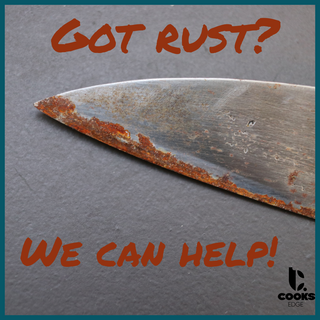Do you have a rusty knife that could use a little TLC? If you are local or willing to ship your knives, you could always let us take care of that for you. It is our pleasure to return your knives to all their sharp and shiny glory. Otherwise, read on to find out how to deal with a rusty knife.
What Causes a Knife to Rust?
If your knives are not cleaned, dried and stored properly or they are kept in a really humid environment, you may begin to see rust forming on your blade. All it takes for rust to form is iron, oxygen and water (or humidity). Since all knife steel contains iron, all knives are susceptible to rust. A stainless steel knife has some rust resistance because of the addition of chromium. The chromium binds with oxygen to create an outer layer on the knife that protects it from corrosion. This doesn't mean a stainless steel knife can't rust, it is just less likely to. Carbon steel knives, while they have many advantages, are less resistant to rust. In order to protect the integrity of the blade, they do need to be cared for properly. Please see our blog post on knife care for more info.
Rust or Patina?
With use, carbon steel knives will begin to form a patina, a thin protective layer on the surface of the blade. A patina is a beneficial form of oxidation that will turn the blade a mix of gray, blue and black hues. The best part about having a patina form is that it can actually help to protect your blade from rust as well as adding to the beauty and uniqueness of your knife.
You can tell the difference between rust and a patina by looking at the color. If you see an orange color or pitting of the blade, it is likely rust has started to form.
Removing Rust:
A heavily pitted and damaged blade may need to be fixed by a professional knife sharpener, but a little bit of rust can easily be removed at home. If only a small amount of rust has formed, first try using a soft scrubbing pad (nothing too abrasive like steel wool) and some hot soapy water to gently scrub it away.
If that doesn't work, you can try a Rust Eraser. This handy tool should make quick work of removing any rust. You want to make sure to wet the eraser before use otherwise it could further damage the blade. Then just gently rub the eraser back and forth over the area that is rusted, going in the same direction. It shouldn't take long before the rust is all cleaned off.
Now that you have removed the rust, it is a good time to brush up on your knife care knowledge and prevent your knife from rusting in the future. If you have a highly reactive knife that rusts easily, you may want to invest in some Camellia Blade Oil to further protect your knife.
Stay sharp (and rust-free) everyone!


